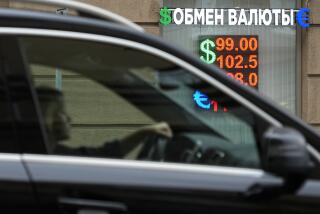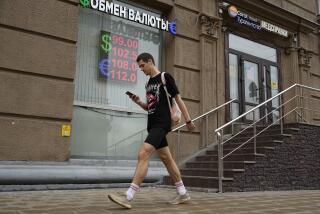Sharp Drop by Ruble Belies Talk of Economic Stability : Russia: One-quarter fall against dollar raises doubts about ability to control currency during post-Communist reforms.
- Share via
MOSCOW — The enfeebled Russian ruble tumbled by more than one-quarter of its value against the dollar Tuesday in a day of panicked trading that heralded greater inflation and instability just as the Kremlin seemed to have the economy nearly under control.
The ruble fell from 3,081 to the dollar to 3,926, a record drop that prompted Russians to dub the day “Black Tuesday.” Overall, the ruble’s value has been cut in half since July.
“What has happened to the supposedly stabilized economy?” demanded the evening newspaper Izvestia. “What can we expect tomorrow and the day after?”
In a country now getting used to financial debacles, from ill-considered money swaps to massive pyramid schemes, this was one of the biggest, casting doubt on the government’s ability to control its currency as it navigates through tricky, post-Communist economic reforms.
“The jump of the dollar on the currency market is a basis for throwing (Prime Minister Viktor S.) Chernomyrdin into prison,” prominent businessman Konstantin Borovoi fumed in print. “In any other country, after such a jump of the dollar against the national currency there would be a revolution.”
In fact, no revolution threatened; money-exchange booths in Moscow remained calm, and people in line groused quietly about the speculators who were probably making fortunes off the sharp change in rate. The Central Bank intervened in trading on the Moscow Interbank Currency Exchange, the country’s largest, to keep the ruble from falling below 4,000 to the dollar.
But the possible consequences of the ruble drop worried both Western and Russian economists deeply.
“The continuing sharp drop of the ruble to the dollar means an intensive crescendo of inflation,” Alexander Zhukov, a member of the Russian Parliament’s Budget Committee, told the Itar-Tass news agency.
As the dollar gains in strength, imported goods become relatively more expensive for Russians to buy with their ruble salaries, and those price hikes fuel inflation. By Tuesday evening, the new rate’s effect could already be seen in the fresh, inflated price tags on beer and candy in many of the city’s kiosks. Lines in stores and at gas stations also lengthened as customers struggled to unload their rubles fast.
Western economists warn that with the inevitable rise in prices comes a temptation for the Kremlin to print more money and issue more cheap loans to ease the burden on people. That would fuel inflation even further.
“Obviously what’s happened is going to complicate things,” said a Western economic adviser to the government. “Certainly there’s been a loss of confidence--the markets are all voting on that.”
“If there is a retreat back to a pro-inflation psychology, to investing in the dollar and daily spending rather than saving, we will have lost this year, a difficult year of deprivations,” said Alexander Livshits, a top economic adviser to President Boris N. Yeltsin. “We simply cannot allow this to happen.”
The only winners in the ruble crash--aside from smart speculators--seemed to be Russia’s exporters, the oil and metal magnates who now can offer their goods abroad at lower prices.
“It’s heaven for exporters and hell for importers,” said economist Pavel Bunich of the new ruble rate.
Most economists said the ruble fell so sharply mainly because of panic selling, but there was also an objective reason. Beginning last month, the Central Bank stopped propping up the ruble by injecting hundreds of millions of dollars into the foreign exchange market.
The Central Bank “had seen the bottom of its own well,” Bunich said, after it had spent more than $2 billion on buying up rubles over the last two months.
Trading of the ruble, mainly for dollars and German marks, has gone on since 1992 at the Moscow exchange, but the ruble is still not fully convertible throughout the world, and the government has kept a tight hold on its rate.
When the hold loosened, economists said, the ruble’s fall was inevitable. Some are predicting that the ruble will rise back to about 3,000 to the dollar when the speculation and panic cool down.
But meanwhile, the powerful dollar has Russian importers, whose goods have suddenly skyrocketed in price, near despair. Many are simply freezing their operations until the dollar rate settles down, Russian media reported.
More to Read
Sign up for Essential California
The most important California stories and recommendations in your inbox every morning.
You may occasionally receive promotional content from the Los Angeles Times.













